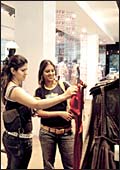 |
SUBHIKSHA'S SUBRAMANIAN
His no-frills approach seeks to gain critical mass
in one region before moving on to the next |
In less than
a decade, R. Subramanian has turned his no-frills retail outfit,
Subhiksha, into a 183-store chain with Rs 332 crore in annual
revenues. And he's done that by restricting himself to largely
Tamil Nadu (140 stores), although Subhiksha has stores also in
Bangalore and Hyderabad (30 and 13, respectively). Yes, he does
have plans for cities such as Delhi and Mumbai, but Subramanian
would rather gain critical mass in one region before moving to
the next. "At some level, economies of scale are more in
dominating a region than in having a mediocre presence across
multiple regions," he explains. Put simply, that means a
50 per cent share in one region is better than 10 per cent share
each in five different regions.
Subramanian, who intends to have at least
2,500 stores in another five years, isn't the only regional retailer
staying put in and around the base state. All his peers-including
durables retailer Viveks, supermarket chain Nilgiri's and Trinethra-have
similar plans (see Regional Giants). Viveks, for instance, plans
to add 100 stores to the 53 it already has, but primarily in southern
India (although it does have a five-year pan-India plan). Nilgiri's,
which has revenues of Rs 275 crore coming from four self-owned
and 28 franchisee stores, will open 80 to 95 stores over the next
three years, but once again in the home state of TN, and neighbouring
Karnataka and Andhra Pradesh. Ditto Trinethra, which was sold
to private equity firm India Value Fund Advisors by its original
promoter, Anjaneyulu Kakkera. The 127-store Trinethra plans to
touch 200, but only in Andhra, Karnataka and TN. Kakkera has gone
on to float a hypermarket chain called Magna, which also intends
to stay focussed initially on the five states of Andhra, Karnataka,
TN, Maharashtra and Delhi. Again, a pan-India presence is on the
cards, but not for the next three to five years, reveals Kakkera.
There are good reasons for retailers not
wanting to stretch themselves thin. One is, of course, the differences
in regional preferences and tastes. Did you know, for instance,
that rice eaters in the South prefer the ponni variety, while
those in the North like the long-grained and aromatic basmati?
"Five years ago, the share of branded products (in store
sales) was around 30 per cent. Now, it is 50 per cent," says
C. Gopalakrishnan, Managing Director of Nilgiri's, implying how
store-owned brands better match local preferences.
REGIONAL GIANTS
The regional players want to build
their presence in neighbouring states before venture out nationally. |
SUBHIKSHA
Existing Operations: 140 stores in Tamil Nadu, but
has made a soft launch in Bangalore (30 stores) and Hyderabad
(13 stores).
Revenues: About Rs 332 crore. Does roughly Rs 2 crore
per store per annum.
Growth Plans: To go national, but in a regional way,
working in each region as a regional player. Is opening in
Delhi/NCR, Gujarat and Mumbai, besides adding stores in Andhra
Pradesh and Bangalore. Over the next 12 months, would be opening
a large number of stores (maybe 750-800). Five years from
now, plans on having at least 2,500-3,000 stores.
Funding Plans: Has already raised Rs 150 crore by
way of equity and debt.
VIVEKS
Existing Operations: Has 53 stores spread
across Tamil Nadu and Karnataka, with over 222,000 sq. ft
of retail space, supported by three warehouses of over 58,000
sq. ft. Has stores in 19 cities and towns, and under three
different brands: Viveks, Jainsons and Premier.
Revenues: More than Rs 300 crore. Expects to touch
a turnover of Rs 1,000 crore in another five years.
Growth Plans: Looking to grow initially in South
India, followed by other regions, leading eventually to
a pan-India presence. Broadening categories to include computers,
digital cameras and telecom products.
Funding Plans: To tap either private equity investors
or retail investors, besides debt and internal accruals,
to fund the Rs 125 crore it will need to add another 100
stores over the next three years.
NILGIRI'S
Existing Operations: Four supermarkets run by the
promoter family. Those apart, there are 28 franchisee outlets
spread across Karnataka, Tamil Nadu, Pondicherry, Kochi
and Andhra Pradesh.
Revenues: Rs 275 crore in 2005-06 and expects to
do more than Rs 350 crore in 2006-07.
Growth Plans: Over the next three years, to add
25 to 30 stores in Karnataka, 35 to 40 stores in Tamil Nadu
and 20 to 25 stores in Andhra Pradesh.
Funding Plans: Evaluating various options, but is
most likely to rope in a strategic investor soon.
TRINETHRA
Existing Operations: 127 outlets (including 14 in
Chennai and 25 in Bangalore-previously these were of Fabmall).
Revenues: Rs 190 crore
Growth Plans: To focus on South India first rather
than be thinly spread nationally. The goal is to reach 200
stores in Andhra, Karnataka and Tamil Nadu by March 2007.
In November last year, it entered Chennai. Is today adding
four to five stores per month in Chennai and Bangalore.
Funding Plans: The retailer is largely owned (over
75 per cent) by India Value Fund Advisors, a private equity
firm. Therefore, a strategic sale may not be too far in
the future.
|
 |
VIVEKS' KODANDARAMA
SETTY
The consumer electronics retailer sees consumer loyalty
as its pay-off in being wedded to a broad region |
For a retailer, achieving economies of scale
in purchase while customising products to fit the profile of different
stores will be expensive and cumbersome, if not impossible. Why?
Because any large retail chain operates on a hub-and-spoke model,
and being in, say, four different regions would mean creating
four hubs without any guarantee of four-fold increase in revenues.
Says Subramanian: "Mindless expansion is not the answer.
Regional retailers need to understand their strengths and dig
deeper within their region, but they could expand horizontally
into more categories."
While that may be true in the case of a supermarket,
does a consumer electronics and durables retailer like Viveks
need to worry about regional preferences too? "Various studies
and consumer surveys have revealed that consumers tend to trust
our name more than the brand itself," says B.A. Kodandarama
Setty, Chairman and Managing Director of Viveks.
As Kavil Ramachandran, Professor of Entrepreneurship
at the Hyderabad-based Indian School of Business says, the entry
of bigger players will mean changes, "but with growing consumerism
and sharp regional preferences, both big chains and regional players
can co-exist". After all, retailers aren't dealing with one
India, but multiple Indias.
|
West In East
Foreign retailers are happy
to have a limited presence in the country, until regulations
and market growth allow them to expand.
By Shaleen Agrawal
|
 |
 |
PREMIUM
POSITIONING
Retailers like Mango (left) and Tommy Hilfiger have
a limited market for their high-priced products in a
nation that has just 6 million rich households |
Mango, a Spanish retailer of
women's fashion clothing, has been in India for almost five
years now, and guess how many stores it has in the country?
A measly three, with one each in Mumbai, Delhi and Bangalore.
Marks & Spencer (M&S), one of UK's best-known retailers
selling everything from foods to apparel to financial services,
has a bigger presence in India, but only sells clothes and
that too through nine stores, although it has been around
for five years too. So why aren't foreign retailers like Mango
and M&S expanding faster in the country. One reason is,
of course, that they were not allowed until very recently
to invest directly in retail. So both of them work through
franchisees: Mango has Major Brands India and M&S, Planet
Sports, where Pantaloon Retail's Kishore Biyani owns a 49
per cent share.
The other reason-and the bigger of the two-is the nature
of the market itself. According to an Ernst & Young
report on Indian retail, there are 209 million households,
of which just 6 million are considered 'rich'-that is, having
an annual income of over $4,700, or Rs 2,11,500. More than
half of these 'rich' families live in Delhi, Mumbai and
Bangalore, and spend around $18 billion (Rs 81,000 crore)
each year. Given that prices of clothes at Mango and M&S
start at an average Rs 600-750 for T-shirts and tops, and
Rs 1,000 for formal shirts, there aren't too many people
outside the metros who can afford shopping at these retailers.
Says Isak Halfon, Head (Expansion), Mango: "Mango offers
fashion-quality products to its clients, and that naturally
positions the brand in a reduced segment of customers who
are familiar with the brand and can afford it."
Elsewhere in the world, Mango, which has 750 stores in
73 countries, is an affordable mass market brand. So why
is Mango positioned as a premium brand in India? Again,
the reason has to do with the limited size of the market.
Explains Asitava Sen, Principal Consultant, PricewaterhouseCoopers:
"The scale of operations is an issue. They cannot do
local sourcing because of the low scale and, therefore,
end up charging a premium for their products." Besides,
why would this cream of Indian consumers buy a made-in-India
Mango or m&s when it can shop for their clothes on any
of their foreign trips? Says Suresh Bhatia, Director (Major
Brands), the Mango franchisee: "In India duty structures
are high and, therefore, things are costlier."
Yet, not only will more foreign retailers enter India,
but the existing ones will expand. Mango plans to open five
to seven stores over the next two years; M&S hopes to
roll out 50 new stores by 2011; and a host of others-ranging
from Starbucks to Home Depot to Ikea to Tesco-is tying up
their entry plans. Says Sen: "They are all interested
in going to a market where the growth potential is huge.
In the next 10 years, they will have a chance to expand
at their will." For most of the foreign retailers,
not being in India is not an option.
|
|







